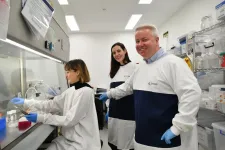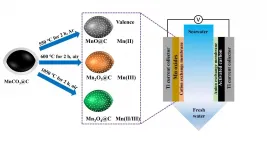(Press-News.org) An analysis led by North Carolina State University researchers found counties with more socially vulnerable populations had a higher density of natural gas pipelines overall.
The findings suggest counties that are more socially vulnerable are also at greater risk of facing water and air pollution, public health and safety issues, and other negative impacts associated with the pipelines.
"We know that the network, as it stands today, is already distributed in such a way that any negative impacts fall disproportionately on vulnerable communities," said the study's lead author, Ryan Emanuel, a professor of forestry and environmental resources at NC State. "Right now, when regulators evaluate the social impacts of these projects, they are treated in isolation, and not as part of a massive network that affects more than 70 percent of all the counties in the U.S."
In the analysis, researchers used a measure of social vulnerability created in 2018 by the U.S. Centers for Disease Control and Prevention to assess 3,142 U.S. counties. The index combines information on household composition, age, disability status, race or ethnicity, language, and other factors to quantify a county's ability to bounce back from a disaster.
Then, using data from the U.S. Energy Information Administration, researchers evaluated how the approximately 229,000 miles of pipeline network in the United States mapped on top of counties, stratified by their social vulnerability scores.
"We studied the gas gathering and transmission pipelines, which are the really large and high-pressure pipelines that are meant to transport natural gas across regions or the country," Emanuel said. "We know that every year, there are explosions on transmission pipelines, and we have records for those accidents above a certain size. There are also air quality impacts at compressor stations that power them, and environmental damages that occur during construction."
For the 2,261 counties with pipelines in them - about 72 percent of U.S. counties - researchers found a correlation between counties with higher scores of social vulnerability, and the density of pipeline infrastructure.
"In general, the denser the pipeline network, the higher the social vulnerability score," said study co-author Louie Rivers III, associate professor of forestry and environmental resources at NC State. "The indication is the most vulnerable populations are also vulnerable to exploitation in terms of what people do with the land near them."
For planning the path of future projects, researchers say more nuance is needed in the regulatory process to evaluate communities. While population density is used as a factor used by regulators in assessing the severity of negative impacts of pipelines, density alone could overlook ways in which rural communities may be more vulnerable.
"When you evaluate the pipeline project for a rural area, you can't just assume that the concerns of a rural community are just going to be low-density versions of urban concerns," Emanuel said. "Rural issues are not less intense versions of urban issues. We also know from past research that these projects can have a destabilizing influence on rural communities."
Researchers also highlighted impacts of pipeline infrastructure on Indigenous communities in the U.S. They noted the Dakota Access, Keystone XL, Trans Mountain expansion and Enbridge Line 3 pipelines cross, or are proposed to cross, Indigenous territories in the U.S. and Canada. This raises concerns for communities about not only pollution or risks for health, but also for cultural harm to places with religious, historical or cultural significance.
The researchers pointed to the need to improve environmental assessments of potential pipeline infrastructure on vulnerable populations to prevent these networks from disproportionately impacting socially vulnerable people. They also called for better inclusion of community perspectives into decision-making.
"We need the same level of rigor applied to the issue of environmental justice in environmental impact statements as we see for other sections, such as water and air quality," Rivers said.
And while the existing infrastructure may have been built before federal policies were enacted to address environmental justice and antidiscrimination, researchers said federal regulators specifically need to assess the location of infrastructure networks as a whole in future planning to avoid reinforcing historic oppressive practices.
They also suggested assessing the cumulative impacts of all nearby infrastructure on factors such as air quality, noise and explosion risks.
"We need a comprehensive approach to environmental justice analyses that considers the larger network of infrastructure in which individual projects exist," Emanuel said.
INFORMATION:
The study, "Natural Gas Gathering and Transmission Pipelines and Social Vulnerability in the United States," was published open access in the journal GeoHealth. The paper was co-authored by Martina Angela Caretta of Lund University and Pavithra Vasudevan at the University of Texas at Austin.
Note to editors: The abstract follows.
"Natural Gas Gathering and Transmission Pipelines and Social Vulnerability in the United States."
Authors: Ryan E. Emanuel, Martina Angela Caretta, Louie Rivers III and Pavithra Vasudevan.
DOI: 10.1029/2021GH000442
Published online in GeoHealth May 18, 2021.
Abstract: Midstream oil and gas infrastructure comprises vast networks of gathering and transmission pipelines that connect upstream extraction to downstream consumption. In the United States (US), public policies and corporate decisions have prompted a wave of proposals for new gathering and transmission pipelines in recent years, raising the question: Who bears the burdens associated with existing pipeline infrastructure in the US? With this in mind, we examined the density of natural gas gathering and transmission pipelines in the US together with county-level data on social vulnerability. For the 2,261 US counties containing natural gas pipelines, we found a positive correlation between county-level pipeline density and an index of social vulnerability. In general, counties with more socially vulnerable populations have significantly higher pipeline densities than counties with less socially vulnerable populations. In particular, counties in the top quartile of social vulnerability tend to have pipeline densities that are much higher than pipeline densities for counties in the bottom quartile of social vulnerability. The difference grows larger for counties at the upper extremes of pipeline density within each group. We discuss some of the implications for Indigenous communities and others affected by recent expansions of oil and gas infrastructure. We offer recommendations aimed at improving ways in which decision-makers identify and address the societal impacts and environmental justice implications of midstream pipeline infrastructure.
Hormonal contraceptives, e.g. the pill, the patch, and the vaginal ring, contain synthetic hormones that prevent pregnancy by either stopping ovulation, changing the cervical mucus to stop sperm from passing through the cervix and finding an egg, or changing the womb's lining to prevent a fertilized egg from being implanted in it.
Despite their widespread use, hormonal contraceptives are known to increase the risk of breast cancer, which is the most common cause of cancer-related death among women worldwide, and also topped the list of most commonly diagnosed cancers in 2020.
The main component of hormonal contraceptives are progestins, ...
Anesthesia may be an exact science, but it's not yet fully personalized. Anesthesiologists use a variety of methods to calculate the right dose for a given patient: clinical studies, medical databases and laboratory measurements, for example. However, every individual responds to anesthetics in a different way, and there's no way of knowing what that response will be until the anesthetic is administered.
Personalizing dosage
Today patients often receive supplemental doses of an anesthetic during their operation based on their reaction. The role of anesthesiologists is to make sure that a patient doesn't wake up too soon and has no memory of the procedure, but they must use ...
Scientists from the Wellcome Sanger Institute and the University of Cambridge found that in children with neuroblastoma - a cancer of immature nerve cells - treatment with platinum chemotherapy caused changes to the genome that could then cause leukaemia in some children later on.
The findings, published 27th May 2021 in Blood could lead to an ability to identify which children are more likely to develop the secondary cancer. This in turn could lead to changes in their treatment plan to either avoid these risks or take measures to prepare.
Secondary blood cancer is a challenging complication of childhood neuroblastoma cancer treatment. Every year around 100 children in the UK are diagnosed with neuroblastoma*, ...
The group of experts includes Professor and Academician of Tallinn University of Technology Jarek Kurnitski, who said that improving ventilation can be regarded more broadly as a paradigm shift equal in scale to the transformation in the standards of drinking water supplies and food hygiene. "There has long been no doubt that you can get infection when you drink water or eat food that has been contaminated. Now we must work towards providing clean air so we can breathe safely," Kurnitski said.
He added, "Researchers see updating of ventilation standards, ventilation requirements based on the probability of infection and more efficient and flexible ventilation systems as a solution. High air change rates are required only in the event of an epidemic, at any ...
Varying immune response to vaccinations could be countered with microbiota-targeted interventions helping infants, older people and others to take full advantage of the benefits of effective vaccines, Australian and US experts say.
A comprehensive review in Nature Reviews Immunology concludes that evidence is mounting in clinical trials and other studies that the composition and function of individuals' gut microbiota are "crucial factors" in affecting immune responses to vaccinations.
"Never before has the need been greater for robust and long-lasting immunity from our vaccination programs, particularly in low and middle-income countries, and for populations at increased ...
Researchers at the University of Adelaide are concerned video sharing platforms such as YouTube could be contributing to the normalisation of exotic pets and encouraging the exotic pet trade.
In a study, published in PLOS ONE, researchers analysed the reactions of people to videos on YouTube involving human interactions with exotic animals and found those reactions to be overwhelmingly positive.
The researchers analysed the reactions - via text and emoji usage - in comments posted on 346 popular videos starring exotic wild cats and primates in 'free handling situations'.
These situations involved exotic animals interacting with humans or other animals, such as domestic cats and dogs. The videos examined received ...
Public use of parks and reserves increased only slightly during last year's COVID-19 national lockdown despite gyms and sports facilities shutting down, a University of Queensland study found.
UQ School of Biological Sciences PhD candidate Violeta Berdejo-Espinola surveyed 1000 people in Brisbane, measuring their use of urban green space and the benefits people associated with visiting the areas during lockdown.
"People all around Brisbane, myself included, noticed a boom in park use in 2020, but while more people ventured into local parks, many folks were left indoors," Ms Berdejo-Espinola said.
"Thirty-six ...
Professor YAO Huajian's research group from the School of Earth and Space Sciences of the University of Science and Technology of China (USTC), in cooperation with Dr. Piero Poli from Grenoble-Alpes University of France, combined the unique resolution reflected body waves (P410P and P660P) retrieved from ambient noise interferometry with mineral physics modeling, to shed new light on transition zone physics. Relevant work was published in Nature Communications.
The subduction of oceanic slabs is an important process of the earth's internal material circulation. Studying the ...
Recently, the researchers from Institute of Solid State Physics, Hefei Institutes of Physical Science (HFIPS) of the Chinese Academy of Sciences, by using valence engineering, developed three manganese oxides as electrodes with different Mn valences for high-performance capacitive desalination.
Reverse osmosis and thermal distillation are widely used to treat salt water with high salt concentration, but they have disadvantages including high energy consumption and high cost.
As an alternative method, capacitive deionization (CDI) technology can remove charged ions ...
University of Virginia School of Medicine researchers have shed new light on how our brains develop, revealing that the very last step in cell division is crucial for the brain to reach its proper size and function.
The new findings identify a potential contributor to microcephaly, a birth defect in which the head is underdeveloped and abnormally small. That's because the head grows as the brain grows. The federal Centers for Disease Control estimates that microcephaly affects from 1 in 800 children to 1 in 5,000 children in the United States each year. The condition is associated with learning disabilities, developmental delays, ...





